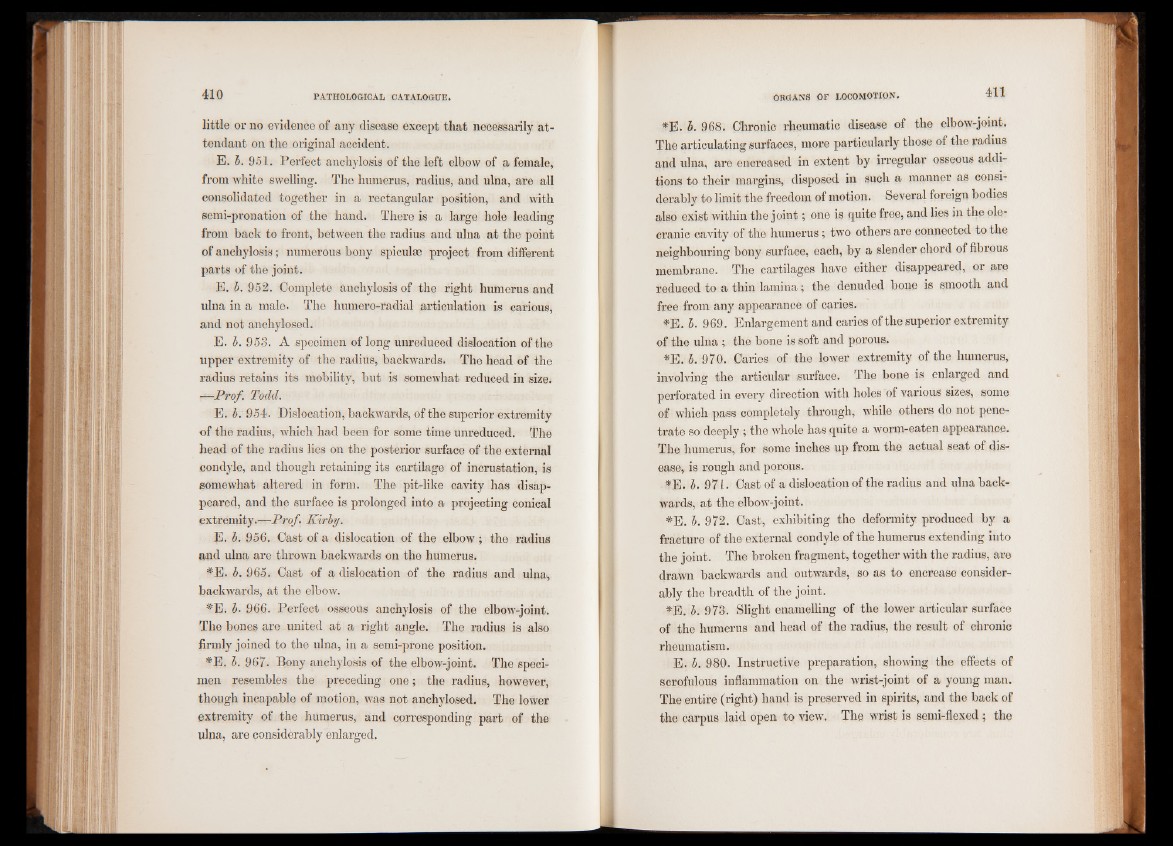
little or no evidence of any disease except that necessarily attendant
on the original accident.
E. b. 951. Perfect anchylosis of the left elbow of a female,
from white swelling. The humerus, radius, and ulna, are all
consolidated together in a rectangular position, and with
semi-pronation of the hand. There is a large hole leading
from back to front, between the radius and ulna at the point
of anchylosis; numerous bony spiculse project from different
parts of the joint.
E. b. 952. Complete anchylosis of the right humerus and
ulna in a male. The humero-radial articulation is carious,
and not anchylosed.
E. b. 958. A specimen of long unreduced dislocation of the
upper extremity of the radius, backwards. The head of the
radius retains its mobility, but is somewhat reduced in size.
—Prof. Todd.
E. b. 954. Dislocation, backwards, of the superior extremity
of the radius, which had been for some time unreduced. The
head of the radius lies on the posterior surface of the external
condyle, and though retaining its cartilage of incrustation, is
somewhat altered in form. The pit-like cavity has disappeared,
and the surface is prolonged into a projecting conical
extremity.—Prof. Kirby.
E- b. 956. Cast of a dislocation of the elbow; the radius
and ulna are thrown backwards on the humerus.
#E. b. 965. Cast of a dislocation of the radius and ulna,
backwards, at the elbow.
#E. b. 966. Perfect osseous anchylosis of the elbow-joint.
The bones are united at a right angle. The radius is also
firmly joined to the ulna, in a semi-prone position.
#E. b. 967. Bony anchylosis of the elbow-joint. The specimen
resembles the preceding one; the radius, however,
though incapable of motion, was not anchylosed. The lower
extremity of the humerus, and corresponding part of the
ylna, are considerably enlarged.
*E. b. 968. Chronic rheumatic disease of the elbow-joint.
The articulating surfaces, more particularly those of the radius
and ulna, are encreased in extent by irregular osseous additions
to their margins, disposed in such a manner as considerably
to limit the freedom of motion. Several foreign bodies
also exist within the joint; one is quite free, and lies in the ole*
cranic cavity of the humerus; two others are connected to the
neighbouring bony surface, each, by a slender chord of fibrous
membrane. The cartilages have either disappeared, or are
reduced to a thin lamina; the denuded bone is smooth and
free from any appearance of caries.
*E. b. 969. Enlargement and caries of the superior extremity
of the ulna ; the bone is soft and porous.
*E. b. 970. Caries of the lower extremity of the humerus,
involving the articular surface. The bone is enlarged and
perforated in every direction with holes of various sizes, some
of which pass completely through, while others do not penetrate
so deeply ; the whole has quite a worm-eaten appearance.
The humerus, for some inches up from the aetual seat of disease,
is rough and porous.
*E. b. 971. Cast of a dislocation of the radius and ulna backwards,
at the elbow-joint.
#E. b. 972. Cast, exhibiting the deformity produced by a
fracture of the external condyle of the humerus extending into
the joint. The broken fragment, together with the radius, are
drawn backwards and outwards, so as to encrease considerably
the breadth of the joint.
*E. b. 973. Slight enamelling of the lower articular surface
of the humerus and head of the radius, the result of chronic
rheumatism.
E. b. 980. Instructive preparation, showing the effects of
scrofulous inflammation on the wrist-joint of a young man.
The entire (right) hand is preserved in spirits, and the back of
the carpus laid open to view. The wrist is semi-flexed; the